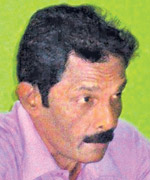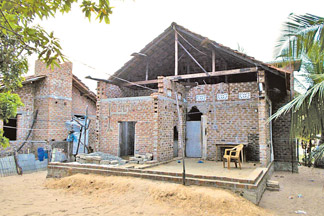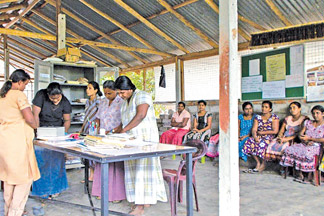Pilot projects to develop Batticaloa district
By Anuradha KODAGODA
|

Deputy Mayor - A. Goerge
Pillai
|
It is a well known fact that most of the cities in the country face
at least one repercussion from the impacts of climate change. According
to analysis of 40-year records of daily temperature data, Batticaloa has
revealed a strong trend of temperature increase of 0.4-0.5 Centigrade
during the past two decades in comparison to the previous two decades.
In addition, rainfall analysis has revealed a strong trend of monsoon
rainfall increase (28% in Batticaloa Municipal Council) and
correspondent increase of occurrence of minor floods. BMC has
experienced the largest flood during the past 100 years during December
2009 -January 2010.
“This flood resulted in the loss of life and property while
significantly damaging the emerging coastal tourism industry. 15%-20% of
the total population in the Batticaloa Municipal Council will be
vulnerable to sea level rise in 2040.
Frequently increasing storm surges have also resulted in significant
losses to livelihoods in these areas,” talking to the Sunday Observer
Dr. Fahmy Ismail, National Technical Advisor, UN habitat said.
“This information follows the findings of the Cities and Climate
Change Initiatives Pilot Project implemented by the University of
Moratuwa and UN-HABITAT as the first initiative to address the City
Level Climate Change impacts in Sri Lanka.
As many other coastal cities have experienced devastating climate
related impacts during the recent years, this Project focuses on the
most urgent and immediate needs of the Sri Lankan coastal cities in
adapting to climate change, and mitigating risks and the severity of
impacts through Disaster Risk Management (DRM),” he further added.

UN Habitat funded house |

Women's bank weekly meeting |
This project will support key stakeholders in the BMC to develop and
implement the activities such as, multi-purpose green belt in BMC coast
established to protect the lagoon and coastal areas, restore mangrove
eco-systems and coastal biodiversity; GIS-based Rapid Response System
(RRS) and Knowledge Management centre for climate exacerbated disasters
established at BMC and NMC with training (one month for 50 selected
participants) and equipment (i.e. building, software, computers, GPS,
printers, scanners, broadband facilities); disaster resilient, energy
efficient, low-cost shelter adaptation training will be provided and
supported by local resource based- livelihood diversifications options
for 100 participants living in vulnerable areas.
70% of Sri Lanka’s urban population and 80% of its economic
infrastructure networks are concentrated in coastal cities which are
highly vulnerable to climate change impacts such as sea-level rise,
flooding, salination of water resources, storm surges, cyclones and
droughts. These impacts disproportionately affect urban poor
communities, who are forced to live in the most vulnerable areas.
Recognising this challenge, BMC conducted vulnerability/adaptation and
Green House Gas assessments in 2010, prioritising strategic response
areas through broad-based stakeholder City Consultations.
The project will document the implementation experiences and share
these through a series of provincial and national consultations.
Supported by the Ministry of Environment, and the Ministry of Local
Government and Provincial Councils and the Urban Development Authority,
the process and lessons learned will be replicated in other cities while
climate resilient approaches will be included in urban planning and
budgetary frameworks.
“The Cities without Slums, is another novel project implemented by UN
Habitat and through that our main intention is to upgrade the living
conditions of the people those who are mainly live in slums areas. To
implement this we selected four cities including Batticaloa. With the
help of the Batticaloa Municipal Council, we selected the areas and the
families of those who need to facilitate through this project. Also, the
support given by the University of Moratuwa is tremendous to do the
survey and collect the exact data.
Through the gathered information we have identified 48 GN divisions
which are with slums and out of this 48 GN divisions we have come across
10 GN divisions whose majority live in slums. Therefore as the first
step we hope to upgrade the living conditions in terms of sanitary
needs, water and shelter facilities which are the most important aspects
that we see as to upgrade the living standards of people. This is not a
project which grants money but grant loans for them considering their
income levels and they can use the money to modify their houses and
improve relevant facilities. The main idea behind granting loans for
them is due to their poor livelihood conditions, as none of the banks
are willing to offer loans.
Therefore, with this initiative they get the opportunity to apply for
a loan. However, the other important factor is that we help them form
small groups and we grant them funding to roll up within that group
while they are influenced to save money every week, This will operate as
a small bank which they have created on their own. With time their
savings become larger and therefore, they can apply for loans according
to their requirements in day-to-day lives. That was the concept that we
adopted one year back and there’s quite a good response from the
communities. Today there is a large number of women groups who obtain
money from the women’s bank and it is becoming larger day by day,” he
said.
Kalawadhi, is the treasurer of the women’s bank for the slum
upgrading project in Kuda East which is a primary branch in Batticaloa.
“With this slum upgrading project which was initiated by the UN Habitat,
our lives have changed significantly. Earlier, none of the State or
private banks provided us any loans even for very small amounts since we
failed to submit any required documents. However, with this new concept
we too could find a solution within ourselves and our communities to
solve our financial issues,” a happy Kalawadhi said.
Re-design of the multi-purpose green belt had been another important
project on ‘Climate resilient action plans for Coastal urban areas in
Sri Lanka’ (CCSL) conducted by UN Habitat. This project is aimed to
develop five Climate Resilient Adaptation strategies and supporting
Action Plans (CRASSAP) in BMC areas.
“It was understood that the presence of green network can
significantly reduce the vulnerabilities of the local communities to the
impacts of the natural disasters exacerbated by climate change. The
project concept and the need of green network for Batticaloa were
evolved by the opinion of local stakeholder during a previous project
titled ‘City Development Strategies to respond climate change in coastal
urban areas of Sri Lanka’, undertaken by UN-Habitat, Sri Lanka in
partnership with University of Moratuwa in 2010. Owing to the importance
of the coastal areas, it was decided to re-design the green belt of the
12km coastal belt. After reviewing the present vegetation pattern in the
area, the re-design of the multipurpose green belt action plan initiates
its activities adhering to the design considerations of resilience to
multi-disaster situations, facilitate the community activities through
spatial re-arrangements, enhance the biodiversity of coastal
eco-systems, protect the coastal beaches and other geo-morphological
forms from sudden wind and wave processes, strengthen the economic
benefit transfers to local community.
Re-design of the multi-purpose green belt, CRASSAP is based on a
series of rapid assessments including Plant inventory of coastal belt,
Land cover mapping, activity survey and a comprehensive local
stakeholder consultation process. As per the findings of baseline
studies, the coastal belt of the area is predominated by planted green
belts.
There were some stretches without green belts while some other
stretches were with recently disturbed vegetation after tsunami (2004)
and flood (2010/11). Need of re-designing of the green belt was well
recognised by local stakeholders, and in order to initiate five sites at
the 12 km stretch were selected to undertake pilot projects. The project
has prepared five action plans with detailed designing of the green belt
for Poonachchimunai, Kallady, Thiruchchendur, Dutch Bar and Navallady
areas,” Dr. Fahmy said. |

